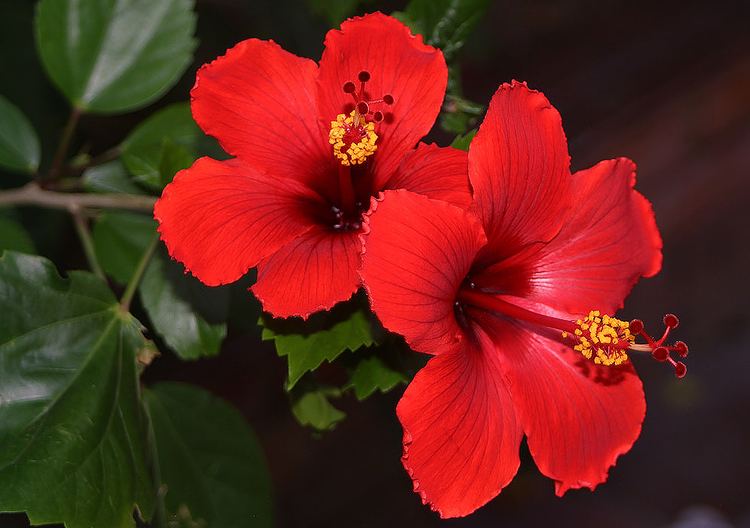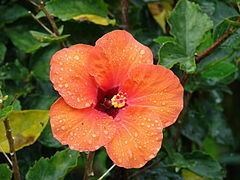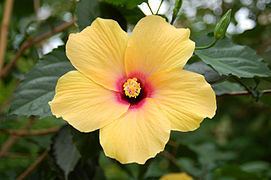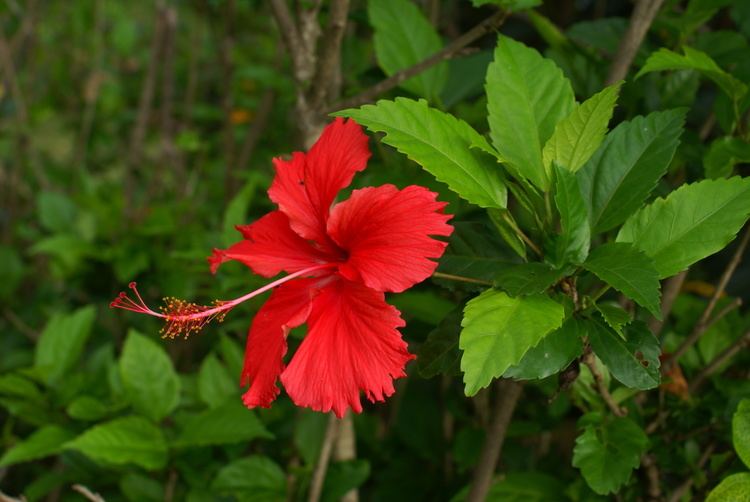Genus Hibiscus Rank Species | Scientific name Hibiscus rosa-sinensis Higher classification Hibiscus | |
 | ||
Similar Hibiscus, Mallows, Common Hibiscus, Bougainvillea, Hibiscus mutabilis | ||
Winter care of the hibiscus rosa sinensis garden savvy
Hibiscus rosa-sinensis, known colloquially as Chinese hibiscus, China rose, Hawaiian hibiscus, and shoeblackplant, is a species of tropical hibiscus, a flowering plant in the Hibisceae tribe of the family Malvaceae, native to East Asia.
Contents
- Winter care of the hibiscus rosa sinensis garden savvy
- Sembaruthi flower hibiscus rosa sinensis adds beauty to your terrace garden poovali news7
- Nomenclature
- Description
- Vegetative characters
- Floral characters
- Ecology
- Genetics
- Uses
- Cultivation
- National symbol
- Gallery
- References

Sembaruthi flower hibiscus rosa sinensis adds beauty to your terrace garden poovali news7
Nomenclature

Hibiscus rosa-sinensis was named in 1753 by Carl Linnaeus in his Species Plantarum. The Latin term rosa-sinensis literally means "rose of China", though it is not closely related to the true roses.
Description

Hibiscus rosa-sinensis is a bushy, evergreen shrub or small tree growing 2.5–5 m (8–16 ft) tall and 1.5–3 m (5–10 ft) wide, with glossy leaves and solitary, brilliant red flowers in summer and autumn. The 5-petaled flowers are 10 cm (4 in) in diameter, with prominent orange-tipped red anthers.
Vegetative characters

The root is a branched tap root. The stem is aerial, erect, green, cylindrical and branched. The leaf is simple, with alternate phyllotaxy and is petiolate. The leaf shape is ovate, the tip is acute and margin is serrated. Venation is unicostate reticulate. (Venation is branched or divergent.) Free lateral stipules are present.
Floral characters
The flower is complete (bisexual), actinomorphic, bracteate or ebracteate, bracteolate or ebracteolate, pedicellate, dichlamydeous, regular, pentamerous, hypogynous, and solitary. It can bloom all year round.
Ecology
Despite its size and red hues, which are attractive to nectarivore birds, it is not visited regularly by hummingbirds when grown in the Neotropics. Generalist species, like the sapphire-spangled emerald, Amazilia lactea, or long-billed species, like the stripe-breasted starthroat, Heliomaster squamosus, are occasionally seen to visit it, however. In the subtropical and temperate Americas, hummingbirds are regularly attracted to it.
Genetics
Hibiscus rosa-sinensis is one of many plant species with a genetic characteristic known as polyploidy, in which there are more than two complete sets of chromosomes, unlike most other species. A side effect of polyploidy is a condition where the phenotype of the offspring may be quite different from the parent, or indeed any ancestor, essentially allowing possibly random expression of all (or any) of the characteristics of all the generations that have gone before. Because of this characteristic, H. rosa-sinensis has become popular with hobbyists who cross and recross varieties, creating new named varieties and holding competitions to exhibit and judge the many resulting new seedlings and often strikingly unique flowers.
Uses
The flowers of Hibiscus rosa-sinensis are edible and are used in salads in the Pacific Islands. The flower is additionally used in hair care as a preparation. It is also used to shine shoes in certain parts of India. It can also be used as a pH indicator. When used, the flower turns acidic solutions to a dark pink or magenta color and basic solutions to green. It is also used for the worship of Devi, and the red variety is especially prominent, having an important part in tantra. In Indonesia, these flowers are called "kembang sepatu", which literally means "shoe flower". In several countries the flowers are dried to use in a beverage, usually tea.
Hibiscus rosa-sinensis is considered to have a number of medical uses in Chinese herbology. It may have some potential in cosmetic skin care; for example, an extract from the flowers of Hibiscus rosa-sinensis has been shown to function as an anti-solar agent by absorbing ultraviolet radiation.
Cultivation
It is widely grown as an ornamental plant throughout the tropics and subtropics. As it does not tolerate temperatures below 10 °C (50 °F), in temperate regions it is best grown under glass. However, plants in containers may be placed outside during the summer months or moved into shelter during the winter months.
Numerous varieties, cultivars, and hybrids are available, with flower colors ranging from white through yellow and orange to scarlet and shades of pink, with both single and double sets of petals. The cultivar 'Cooperi' has gained the Royal Horticultural Society's Award of Garden Merit.
National symbol
Hibiscus rosa-sinensis is the national flower of Malaysia, called Bunga Raya in Malay. Introduced into the Malay Peninsula in the 12th century, it was nominated as the national flower in the year 1958 by the Ministry of Agriculture amongst a few other flowers, namely ylang ylang, jasmine, lotus, rose, magnolia, and medlar. On 28 July 1960, it was declared by the government of Malaysia that Hibiscus rosa-sinensis would be the national flower.
The word bunga in Malay means "flower", while raya in Malay means "celebratory" or "grand". The Hibiscus rosa-sinensis is literally known as the "celebratory flower" in Malay. The red of the petals symbolizes the courage, life, and rapid growth of the Malaysian, and the five petals represent the five Rukun Negara of Malaysia. The flower can be found imprinted on the notes and coins of the Malaysian ringgit.
Gallery
Cultivars with flowers of many colours are used as ornamental plants:
